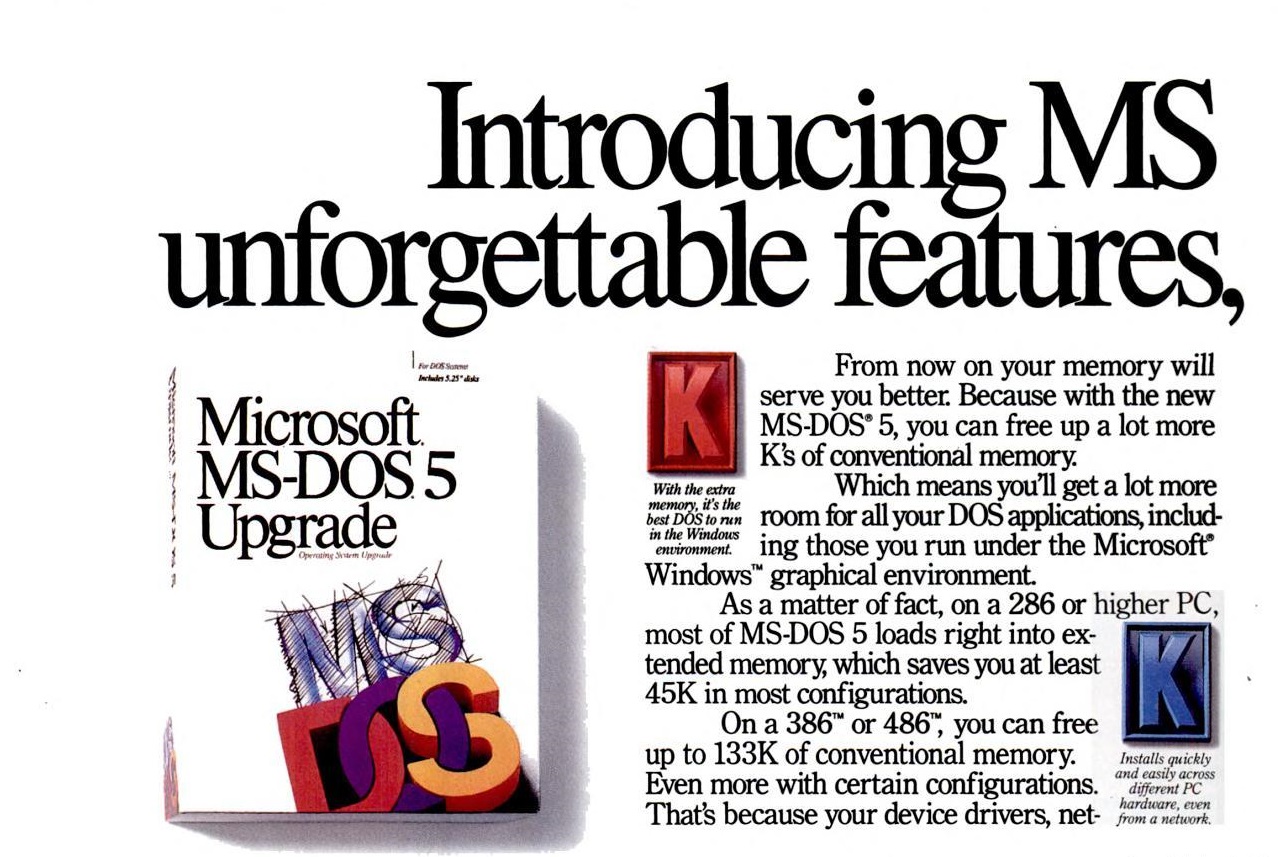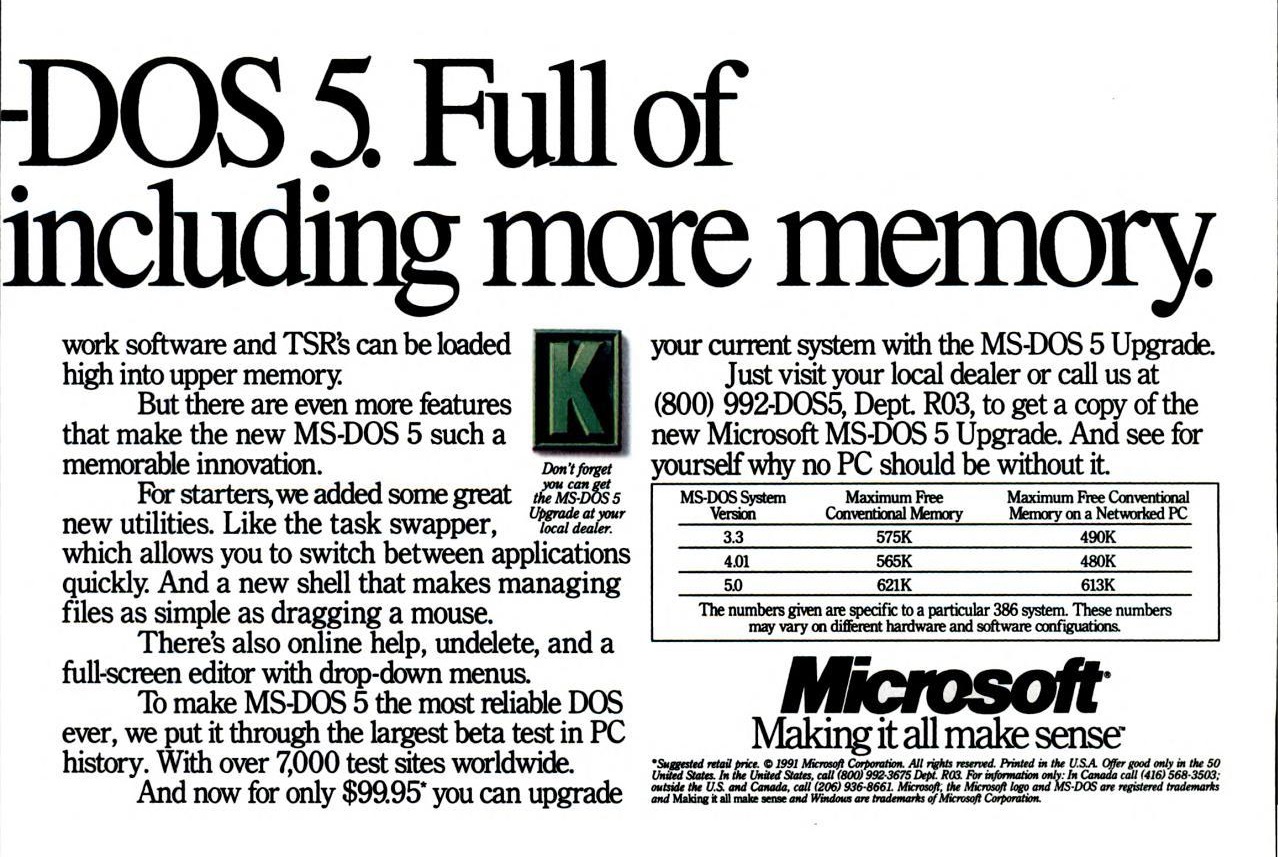DOS Versions
In Part 1 I gave a historical account of how the Disk Operating System (DOS) came to be. In this Part 2 I've listed nearly all versions that were released, in rough chronological order.
Versions (in approximate chronological order)
- Seattle Computer Products SCP 86-DOS 0.1 - Released August 1980. Supported three disk formats on 8" floppy disks - Cromemco/Tarbell 250.25 KB, Tarbell 616 KB and Tarbell 1232 KB (FAT IDs 0xFF and 0xFE).
- Seattle Computer Products SCP 86-DOS 0.3 - Released December 1980.
- Seattle Computer Products SCP 86-DOS 0.42 - Supports FAT12 and CP/M 2 (through RDCPM). Adds 5.25" floppy disk support for NorthStar 87.5 KB and Cromemco 90 KB 5.25" disks.
- Seattle Computer Products SCP 86-DOS 1.0 - Released April 1981. Rebranded QDOS by SCP.
- IBM PC DOS 1.x
- Version 1.0 - First released on 12th August 1981. Same as 86-DOS v1.0 above. Supported only an 8-sector floppy format with a formatted capacity of 160 KB (FAT ID 0xFE) for single-sided 5.25-inch floppy drives.
- Version 1.05 - Internal IBM release only.
- Version 1.1 - Added support for double-sided disk format with 320 KB (FAT ID 0xFF) or 160 KB single-sided.
- Version 1.5 - Unknown changes over v1.1
- Version 1.10 - Released June 1982. Unknown changes over v1.5.
- MS-DOS 1.x
- Version 1.0 - No version 1.0 ever existed - this was 86-DOS v0.3.
- Version 1.10 (OEM) – Released 17th May 1982. Possible basis for IBM's Personal Computer DOS 1.0
- Version 1.11 (OEM) – Released 17th May 1982. Possible basis for IBM's Personal Computer DOS 1.0
- Version 1.14 (OEM) – Released 17th May 1982. Possible basis for IBM's Personal Computer DOS 1.0
- Version 1.24 (OEM) – Released 17th May 1982. Same as IBM's Personal Computer DOS 1.10
- Version 1.25 (OEM) – Released July 1982. This version was the first version that formed the basis for non-IBM OEM versions of MS-DOS, including Seattle Computer Products' SCP MS-DOS 1.25.
-
-
- Compaq-DOS 1.12, a Compaq OEM version of MS-DOS v1.25
- Zenith Z-DOS 1.19, a Zenith OEM version of MS-DOS v1.25
-
- IBM PC DOS 2.x
- Version 2.0 - Released in March 1983 for the price of $60, alongside the IBM PC/XT. New features included Unix-style subdirectories, handle calls, installable device drivers, I/O redirection, support for hard disks (one partition only) and 9-sectors-per-track floppy formats with 180 KB (FAT ID 0xFC) and 360 KB (FAT ID 0xFD) formatted. Supports hard disks up to 16 MB capacity.
- Version 2.1 - Released in October 1983 for the IBM PCjr. No individual country support, but included bugfixes over IBM PC DOS 2.0.
- MS-DOS 2.x – Support for 16 MB hard disk drives (one partition only) and tree-structure filing system.
- Version 2.0 (OEM) - This was the first version with the official name of 'MS-DOS'. It was also the first Microsoft version with support for hard disks.
- Version 2.01 (OEM) - Released 1st May 1983. Added support for individual country formats and the Kanji character set.
- Version 2.10 (OEM) - Released March 1984 for the IBM PCjr.
- Version 2.11 (OEM) - Released March 1984. Cross between PC DOS 2.10 and MS-DOS 2.01. It includes enhancements to better allow conversion into different languages and date formats.
- Version 2.11R (OEM)- Released in 1988 as a bootable ROM DOS for Tandy machines.
- Version 2.12 (OEM) - Released between April and July 1984. Special version for the Texas Instruments Pro.
- IBM PC DOS 3.x
- Version 3.00 - Released in August 1984. Added support for 1.2 MB floppy drive for the IBM PC/AT, some new system calls, new external programs (outside of command.com), support for 16-bit FAT file system (FAT16) so supports hard disks up to 32 MB capacity (one partition only), specific support for IBM network.
- Version 3.10 - Released November 1984. Bug-fix release for v3.00, added general network support.
- Version 3.20 - Released January 1986. Added support for 720 KB 3.5" floppy disk drives and special support for laptops (IBM PC Convertible). "XCOPY" bulk file copying utility added which requires fewer disk swaps.
- Version 3.30 - Released 2nd April 1987 for $120. Designed for the IBM PS/2 series of computers. Added support for 1.44 MB floppy drives, multiple 32 MB DOS partitions, code page switching, improved foreign language support, some new function calls, and support for the IBM PC/AT's CMOS realtime clock.
- Version 3.40 - Internal IBM version never released (4.0 development)
- MS-DOS 3.x
- Version 3.0 (OEM) – Released 14th August 1984. Support for FAT16 file system. First version to support 5.25" 1.2 MB high-density floppy drives and diskettes. Now supports hard disks up to 32 MB capacity.
- Version 3.05 (OEM) - Released November 1984. This was the first non-IBM release of version 3.x.
- Version 3.1 (OEM) – Support for Microsoft Networks
- Version 3.2 (OEM) - First version to support 3.5" 720 KB floppy drives and diskettes.
- Version 3.21 (Retail) - The first version from Microsoft to be sold to the general public.
- Version 3.25 (Retail) - Released January 1986.
- Version 3.3 (Retail) - Released 7th August 1987. First version to support 3.5" 1.44 MB high-density floppy drives and diskettes.
- Version 3.3a (Retail) - Released 24th February 1988.
- Version 3.31 (OEM) – Compaq MS-DOS 3.31 supports FAT16B (with 32-bit sector entries) hence support for larger drives up to 2 GB over up to four partitions. This version was also released for Wyse PCs.
- Version 3.3R (OEM) - Released in 1990 as a bootable ROM DOS for Texas Instruments laptops.
- IBM PC DOS 4.x
- Version 4.00 - Released in August 1988. Support for FAT16B (aka BIGDOS, with 32-bit sector addressing) so breaks the hard disk limit of 32 MB, now supporting capacities up to 2 GB. Also added minor support for EMS (Expanded Memory Specification) and enhanced network support. PCjr support was dropped in this release. Several bugs in this version: (1) its attempt to alleviate conventional memory limitations through the use of hard disk buffers and file management tables being relocated into expanded memory area. This relocation was buggy. (2) DOS 4 allows multi-track reads and writes to the hard disk - a popular hard disk controller at the time had a bug in its microcode which until PC DOS 4 had not manifested - with PC DOS 4, this bug caused irrepairable damage to hard disk data.
- MS-DOS 4.x – includes a graphical/mouse interface for some external tools. It had many bugs and compatibility issues.
An initial release of 4.00 in April 1986(!) to Europe was withdrawn quickly after a very short run. This version added support for multitasking.
- Version 4.00 (Retail) - Released 13th October 1988. Added support for FAT16B (aka BIGDOS) using 32-bit disk sector addressing in the BPB. This meant you could now support hard disks up to 2 GB in capacity. A separate version of v4.00 was released on 21st October 1988, just for 8088/8086 CPUs.
- Version 4.01 (Retail) – Released 2nd December 1988. IBM patched version 4.00 before Microsoft released it. First version to introduce volume serial numbers when formatting hard disks and floppy disks (Disk duplication also and when using SYS to make a floppy disk or a partition of a hard drive bootable). Bug fixes over v4.00.
- Version 4.01a (OEM)
- IBM PC DOS 5.x
- Version 5.0 - Added support for 2.88 MB floppy disk drives that were standard on their IBM PS/2 Model 57 and optional on Models 35 and 40. A full (non-upgrade) version cost $165 for a single licence, with additional licences for $125. At the same time as Microsoft offered their corporate upgrade program IBM announced they would make a PC DOS 5.0 Retail Upgrade available. IBM customers could upgrade to IBM PC DOS 5.0 for $85.
- Version 5.02 - Released in August 1992. A version that could run on non-IBM-built machines.
- MS-DOS 5.x
- Version 5.0 (Retail) – Released 12th April 1991. includes a full-screen editor. A number of bugs required re-issue. First version to support 3.5 inch, 2.88 MB floppy drives and diskettes. First version to support partitions of hard drives up to 2 GB, and up to 8 hard drives total. Also included new 'high memory' support. A ROM-able OEM kit was made available. From June, corporate users could upgrade 100-1000 machines to MS-DOS 5.0 via their MS-DOS 5.0 Upgrade 100% Program for $59 per machine. For companies with less than 100 machines they could buy the License Pak for $79.95. Both schemes also offered additional copies of the documentation for $20 per copy. Tailored versions of MS-DOS 5.0 for Compaq, AST and Hewlett-Packard were produced later in 1991. Advertisements for MS-DOS 5.0 touted that the maximum free conventional memory in 5.0 was 621K, compared to 565K with MS-DOS 4.01, and 575K with MS-DOS 3.3.
- Version 5.0a (OEM) – Released 13th November 1991 for different compatible brands. With this release, IBM and Microsoft versions diverge. This version reports its version as 5.0.
- Version 5.0.500 (WinNT) – All Windows NT 32-bit versions ship with files from DOS 5.0
IBM PC DOS 6.x- Version 6.0 - Released in April 1993, and based on the MS-DOS 6.0 codebase, just like MS-DOS 6.x.
- Version 6.1 - Released in June 1993, and again was based on the MS-DOS 6.0 codebase. Included most of the new features that were added in MS-DOS 6.0 except for DoubleSpace, MS Antivirus, MS Backup and MS Diagnostics. Instead IBM shipped v6.1 with Central Point Backup, Central Point Scheduler, IBM Anti-Virus, QCONFIG (as a replacement to MS Diagnostics). This version reported itself as Version 6.00.
- Version 6.3 - Released in April 1994, and was based on a combination of IBM PC DOS 6.1 and MS-DOS 6.2 codebases (this would be the last version of PC DOS that used any code from Microsoft). Disk compression was added in the form of SuperStor.
- MS-DOS 6.x
- Version 6.0 (Retail) – Available both as a full release or as an upgrade on 30th March 1993. Online help which uses the existing QBASIC editor to show help on DOS commands. Disk compression (DoubleSpace) and anti-virus tool (Microsoft Antivirus) included. Also added support for multiple configurations in CONFIG.SYS and AUTOEXEC.BAT.
- Version 6.1 (none) – IBM and Microsoft alternate DOS 6 versions. IBM released 6.3 also.
- Version 6.2 (Retail) – Available as a full release or as an upgrade on 1st November 1993. For the first time, MS-DOS got an interactive boot option that let you step through CONFIG.SYS and AUTOEXEC.BAT files one line at a time. Ctrl-F5 allowed you to do a clean boot without DoubleSpace. Commas were added to large numbers to help readability in output from DIR, MEM, CHKDSK, and FORMAT commands. A new DISKCOPY program now used hard disk space as a temporary buffer to eliminate disk swaps. DEFRAG was upgraded to handle disks up to 20,000 files. HIMEM.SYS now tested extended memory, and SCANDISK acted as a nice replacement for CHKDSK. Serious bugs were fixed in DBLSPACE.
- Version 6.21 (Retail) – Released as a full release or as an upgrade on 10th March 1994. The Stacker-infringing DBLSPACE removed.
- Version 6.22 (Retail) – Released as a full release or as an upgrade on 31st May 1994. New DRVSPACE (DriveSpace) compression.
- IBM PC DOS 7.x
- Version 7.0 (Retail) - Came in revision 0 and revision 1. Like IBM PC DOS 6.x, IBM continued its development independently of Microsoft, with some useful improvements. Both these revisions still only support FAT16 filesystem and CHS (Cylinder/Head/Sector) hard disk recognition. Revision 1 was called 'PC DOS 2000' and included some bug fixes (especially potential Year 2000 problems). No LFN (Long File Name) support. PC DOS 7.0 was heavily optimised. Its core system and utilities consume less memory than MS DOS, and command.com can be entirely loaded into upper memory. For example, a PC DOS bare system (command.com, himem.sys and emm386.exe) consumes only 13 KB of conventional memory. The same under MS DOS 6.22 consumes 21 KB!
Microsoft BASIC was replaced by IBM's Rexx, a more elegant scripting language developed in-house by IBM. Microsoft Edit was also replaced by E editor (see https://en.wikipedia.org/wiki/E_(PC_DOS)#E_family). The IBM E editor is more powerful in some terms but requires learning.
PC DOS is bundled with the best utilities like Stacker disk compressor. It has an improved setup program, a Microsoft Mouse driver right out of the box, power management (super useful for laptops), an advanced help system, and more.
- Version 7.1 - This was the very last PC DOS version, initially released in 1999 with minor version updates up to December 2003. It was based on the PC DOS 2000 codebase. It supported the FAT32 file system and LBA (Logical Block Addressing) for larger hard disks. It was never released as a retail product, but a number of different builds exist. No LFN (Long File Name) support. Like 7.0, PC DOS 7.1 consumes far less memory than the bulky MS-DOS 7.1.
- Version 7.0 (Provided with Windows 95 / 95A, and never sold separately as an individual version of MS-DOS) – Support for VFAT long file names and 32-bits signed integer errorlevel. New editor. IO.SYS and MSDOS.SYS were now combined into a single IO.SYS file. JO.SYS is an alternative filename of the IO.SYS kernel file and was used as such for "special purposes". JO.SYS allows booting from CD-ROM to hard disk.
- Version 7.1 (Provided with Windows 95B / OSR2 – Windows 98 SE) – Support for FAT32 file system, supporting hard disks up to 124.55 GB in capacity. Last general purpose DOS to be able to load Windows 3.x/95/98 GUI running on top.
- Version 7.0 (Retail) - Came in revision 0 and revision 1. Like IBM PC DOS 6.x, IBM continued its development independently of Microsoft, with some useful improvements. Both these revisions still only support FAT16 filesystem and CHS (Cylinder/Head/Sector) hard disk recognition. Revision 1 was called 'PC DOS 2000' and included some bug fixes (especially potential Year 2000 problems). No LFN (Long File Name) support. PC DOS 7.0 was heavily optimised. Its core system and utilities consume less memory than MS DOS, and command.com can be entirely loaded into upper memory. For example, a PC DOS bare system (command.com, himem.sys and emm386.exe) consumes only 13 KB of conventional memory. The same under MS DOS 6.22 consumes 21 KB!
Microsoft BASIC was replaced by IBM's Rexx, a more elegant scripting language developed in-house by IBM. Microsoft Edit was also replaced by E editor (see https://en.wikipedia.org/wiki/E_(PC_DOS)#E_family). The IBM E editor is more powerful in some terms but requires learning.
PC DOS is bundled with the best utilities like Stacker disk compressor. It has an improved setup program, a Microsoft Mouse driver right out of the box, power management (super useful for laptops), an advanced help system, and more.
- MS-DOS 8.0
- Version 8.0 (Windows ME) – Integrated drivers for faster Windows loading. Four different kernels (IO.SYS) observed.
- Version 8.0 (Windows XP) – DOS boot disks created by XP and later contain files from WinME. The internal command prompt still reports version 5.0
For retro PC enthusiasts today, it is typical to go with MS-DOS 6.22 if you want to run 'pure DOS' as it has all the features you would need, allows for the most free conventional memory of the Microsoft versions, and lots of tweaks to get your system booting optimally. IBM PC DOS 7.0 is even more capable in retaining free conventional memory, and is arguably the best choice of all the DOS versions. If you need long filenames, FAT32, or other newer functionality, it's more likely you are booting into Windows 95 or 98, which installs and sits on top of MS-DOS 7.x. IBM PC DOS 7.1 is also FAT32-compliant, but doesn't support LFN (long file names).

These days, DOS lives on with a widespread support network through FreeDOS, which, since its inception in 1994 has supported the FAT32 filing system (for up to 2 TB LBA hard disks), long filenames, fast networking, and many thousands of third-party utilities and programs. For more information on FreeDOS, visit the official site here.

